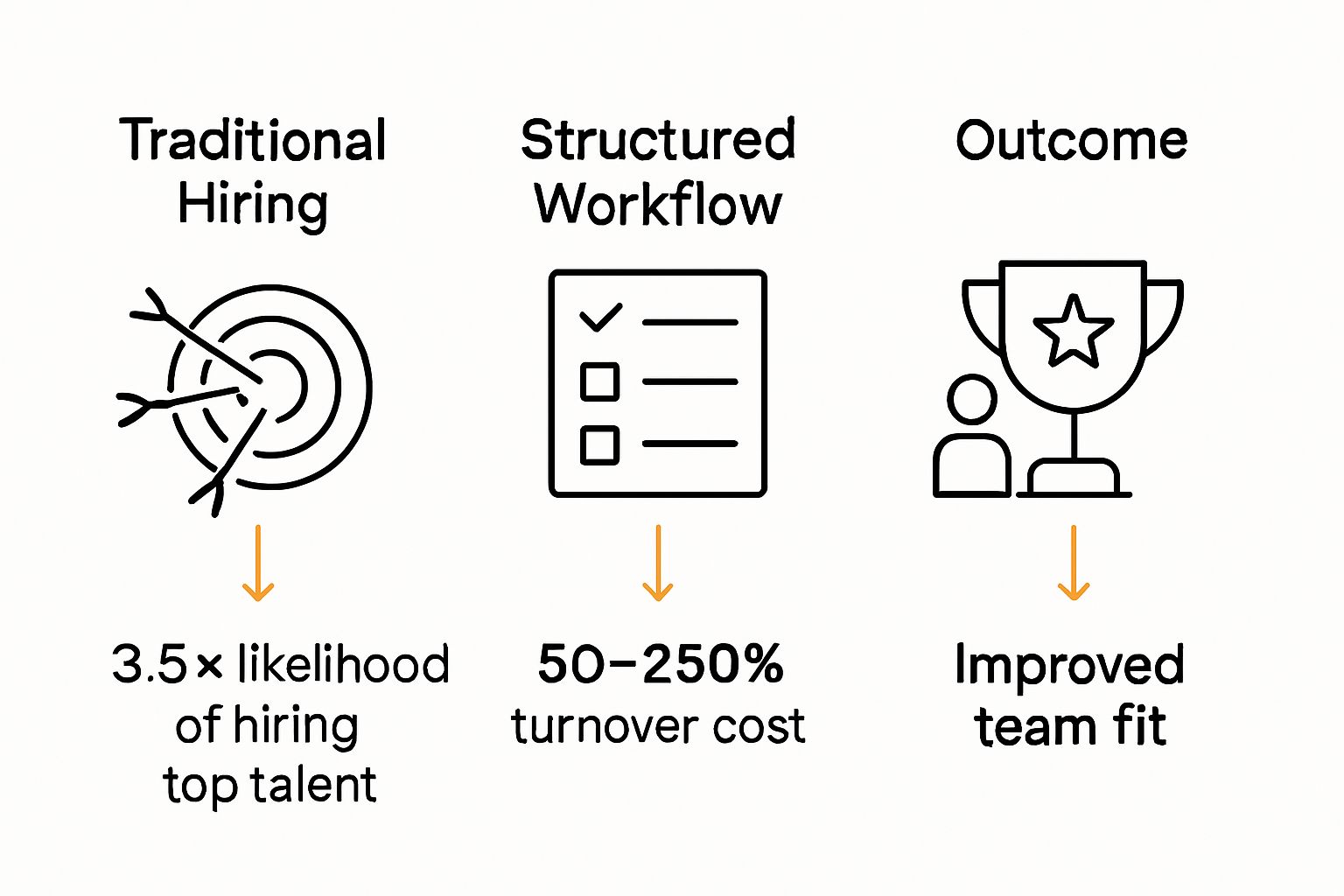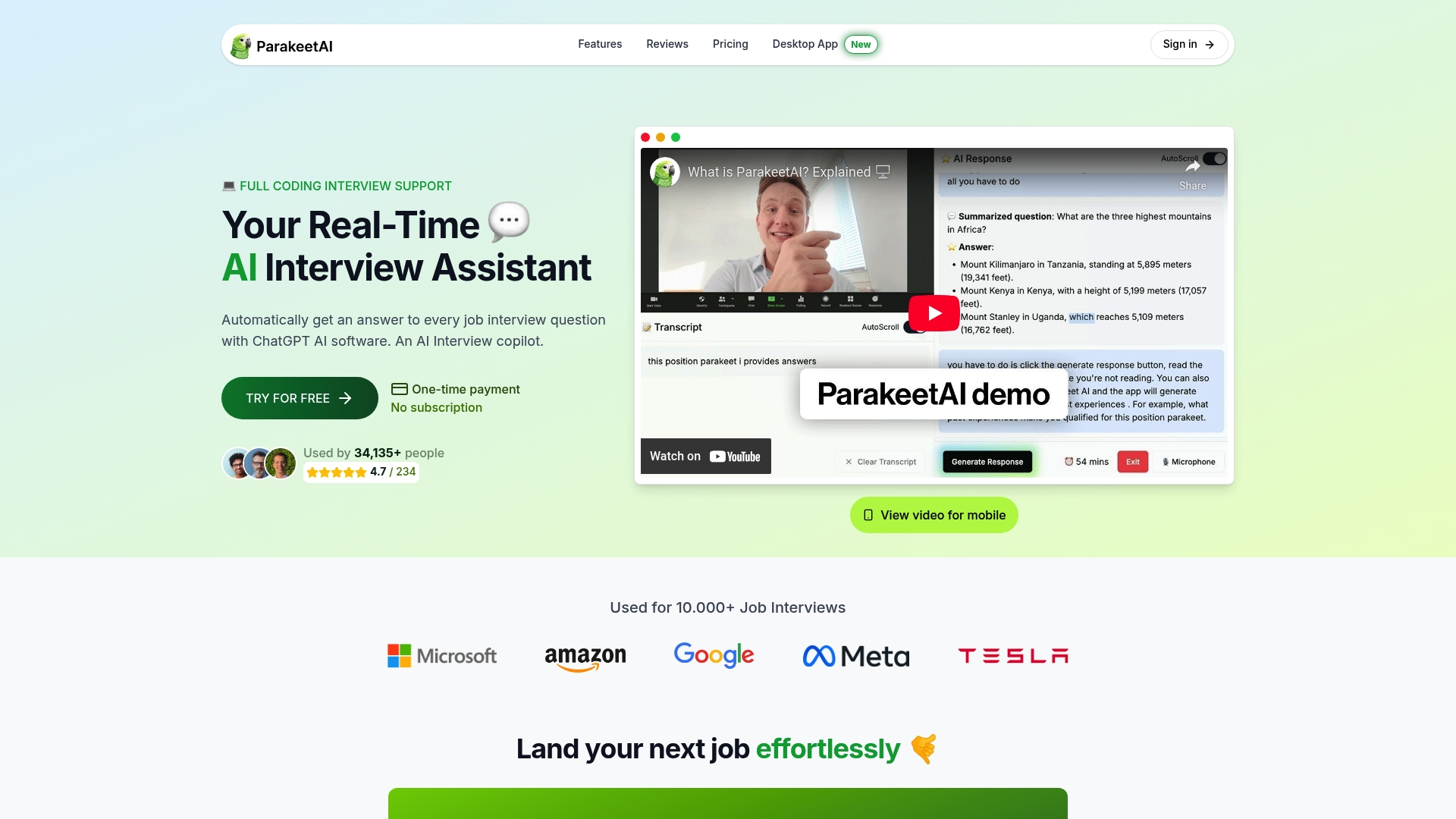Understanding the Interview Assessment Workflow

Hiring talent is not just about resumes and gut feelings anymore. Companies with sophisticated hiring systems are actually 3.5 times more likely to land top-tier candidates than those using old-school methods. Most people think it’s just about asking the right questions and moving on, but the real advantage comes from a structured interview assessment workflow that can completely change how organizations spot future stars.
Table of Contents
- What Is An Interview Assessment Workflow?
- Why The Interview Assessment Workflow Matters
- How The Interview Assessment Workflow Functions
- Key Components Of The Interview Assessment Workflow
Quick Summary
| Takeaway | Explanation |
|---|---|
| Implement Structured Interviews | Structured interviews reduce bias and increase objectivity in candidate evaluation. |
| Utilize Systematic Evaluation Methods | Comprehensive workflows ensure consistent candidate assessments across various stages. |
| Focus on Candidate Fit | Assess both technical skills and organizational culture alignment during hiring. |
| Measure Recruitment Costs | Understanding the costs of bad hires emphasizes the importance of effective interviewing processes. |
| Leverage Data for Hiring Decisions | A data-driven approach enhances the quality of hiring and candidate selection. |
What is an Interview Assessment Workflow?
An interview assessment workflow represents a systematic and strategic approach organizations use to evaluate potential candidates comprehensively and objectively. This structured process transforms traditional hiring methods by introducing a methodical framework that reduces bias and increases the likelihood of selecting the most suitable talent.
Core Components of an Interview Assessment Workflow
At its foundation, an interview assessment workflow encompasses multiple interconnected stages designed to thoroughly examine a candidate’s capabilities, potential, and alignment with organizational requirements. Structured interview processes typically involve several critical elements that work together to create a comprehensive evaluation mechanism.
The workflow generally includes key stages such as:
- Initial candidate screening
- Technical and skills-based assessments
- In-depth behavioral interviews
- Collaborative candidate review
- Final candidate selection and recommendation
Purpose and Significance
The primary objective of an interview assessment workflow is to transform hiring from a subjective selection process into a data-driven, consistent approach. By establishing predefined criteria and systematic evaluation methods, organizations can make more informed hiring decisions that minimize personal biases and maximize candidate potential.
Businesses implementing robust interview assessment workflows gain significant advantages. They can systematically compare candidates, identify the most qualified individuals, and reduce the risk of making poor hiring choices. Read more about AI-powered interview assistance to understand how technology is revolutionizing this critical process.
Unlike traditional hiring methods that rely heavily on intuition, a well-designed interview assessment workflow provides a structured mechanism for collecting, analyzing, and comparing candidate information.
The following table compares traditional hiring methods with structured interview assessment workflows, highlighting core distinctions discussed in the article.
| Hiring Approach | Basis of Evaluation | Bias Level | Consistency | Key Advantage |
|---|---|---|---|---|
| Traditional Hiring Methods | Intuition, informal | High | Low | Fast but unreliable |
| Structured Interview Assessment Workflow | Systematic, data-driven | Low | High | Objective, supports better hiring |
Why the Interview Assessment Workflow Matters
The interview assessment workflow transcends traditional recruitment practices by providing a structured, comprehensive approach to talent acquisition. Organizations recognize that effective hiring goes far beyond merely filling a position its about discovering exceptional candidates who align with both technical requirements and organizational culture.
Strategic Talent Identification
Modern businesses operate in complex environments where talent quality directly impacts competitive advantage.

According to Harvard Business Review research, companies with sophisticated hiring processes are 3.5 times more likely to recruit top-tier talent compared to organizations using traditional methods.
Key strategic advantages include:
- Reduction of unconscious hiring biases
- Systematic evaluation of candidate potential
- Enhanced predictability of candidate performance
- More consistent candidate comparison mechanisms
- Improved long-term organizational fit
Economic and Performance Implications
The financial implications of an ineffective interview process are substantial. Bad hiring decisions can cost organizations significantly more than the initial recruitment expenses. Replacing an employee can range from 50% to 250% of their annual salary, depending on the role’s complexity and seniority.
Businesses seeking to optimize their talent acquisition should explore advanced interview preparation techniques that leverage systematic assessment workflows. These approaches provide a data-driven framework for making nuanced hiring decisions that extend beyond traditional recruitment paradigms.
By implementing a robust interview assessment workflow, organizations transform hiring from a subjective exercise into a strategic talent acquisition methodology. This approach enables companies to build high-performing teams, minimize recruitment risks, and create a sustainable competitive advantage in an increasingly dynamic global marketplace.
How the Interview Assessment Workflow Functions
The interview assessment workflow operates as a sophisticated, multi-stage process that transforms candidate evaluation from a subjective experience into a structured, data-driven methodology. This systematic approach ensures comprehensive candidate examination through carefully designed sequential stages.
Comprehensive Candidate Evaluation Stages
The workflow typically unfolds through interconnected phases that progressively assess a candidate’s suitability. According to Society for Human Resource Management research, successful interview workflows integrate multiple evaluation dimensions to create a holistic candidate profile.
The primary stages include:
- Initial resume and application screening
- Preliminary phone or video screening
- Technical skills assessment
- In-depth behavioral and competency interviews
- Reference and background verification
- Final candidate recommendation and selection
Systematic Assessment Mechanisms
Objective evaluation remains the cornerstone of an effective interview assessment workflow. Each stage incorporates specific tools and techniques designed to minimize bias and maximize insight.

Interviewers utilize standardized scoring rubrics, structured interview protocols, and predefined evaluation criteria to ensure consistent candidate assessment.
Learn more about advanced interview preparation techniques that can help organizations refine their assessment strategies. These methods enable businesses to develop robust frameworks that identify candidates who not only possess required technical skills but also demonstrate alignment with organizational culture and values.
The workflow functions as an integrated system where information from each stage builds a progressively comprehensive understanding of the candidate. By collecting and analyzing data systematically, organizations can make more informed hiring decisions that reduce recruitment risks and increase the probability of long-term employee success.
Key Components of the Interview Assessment Workflow
The interview assessment workflow comprises sophisticated elements that transform recruitment from a traditional process into a strategic talent acquisition methodology. These interconnected components work synergistically to create a comprehensive candidate evaluation system that goes beyond superficial assessments.
To clarify the essential building blocks of a robust interview assessment workflow, the table below outlines its key structural components and their functions.
| Component | Function |
|---|---|
| Standardized Evaluation Frameworks | Ensure every candidate is measured against the same set of criteria |
| Objective Scoring Mechanisms | Provide unbiased, quantifiable ratings for each assessment stage |
| Multi-Stage Assessment Protocols | Structure the process across distinct, sequential evaluation steps |
| Comprehensive Candidate Documentation | Capture detailed evaluation notes and decisions for later reference and review |
| Systematic Performance Benchmarking | Compare candidates based on predefined standards and company performance benchmarks |
Structural Assessment Elements
Effective interview assessment workflows integrate multiple precise and purposeful components that collectively generate a holistic candidate profile. According to MIT Sloan Management Review research, successful organizations design workflows that balance quantitative and qualitative evaluation methods.
Critical structural components include:
- Standardized evaluation frameworks
- Objective scoring mechanisms
- Multi-stage assessment protocols
- Comprehensive candidate documentation
- Systematic performance benchmarking
Evaluation Methodology Dynamics
Each workflow component serves a distinct purpose in extracting meaningful insights about candidate capabilities. Structured interview protocols transform subjective interactions into data-driven assessments by implementing consistent questioning techniques and comparative analysis strategies.
Explore advanced techniques for asking effective interview questions that enable organizations to extract deeper candidate insights. These methodological approaches ensure that evaluation goes beyond surface-level interactions, revealing nuanced information about candidate potential.
The key components function as an integrated ecosystem, where each element contributes unique insights. By meticulously designing workflow components that interact seamlessly, organizations can create a robust talent identification mechanism that minimizes recruitment risks and maximizes the probability of identifying exceptional candidates who align with organizational objectives.
Transform Your Interview Assessment Workflow with Real-Time AI Support
Is your hiring process still struggling with inconsistency or unconscious bias? The article highlighted the need for a structured, objective assessment workflow that minimizes risk and delivers top talent. Yet, many teams still face the pressure of real-time decision making and often wish for smarter support. Imagine turning every interview into an efficient, data-driven experience with live expert assistance.

Now you can. Parakeet AI is a real-time AI job interview assistant that listens to your interviews and instantly supplies AI-generated answers for every question. This powerful technology enhances each stage of your assessment workflow by providing consistent, unbiased evaluation support. Ready to reduce hiring mistakes and identify the best candidates quickly? Visit Parakeet AI today to see how you can revolutionize your interview strategy now. For more ways to build effective hiring processes, learn about advanced interview preparation techniques and discover how structured interviews boost fair assessments. Start transforming your talent acquisition before your next interview.
Frequently Asked Questions
What are the key stages in an interview assessment workflow?
The key stages in an interview assessment workflow include initial candidate screening, technical skills assessments, in-depth behavioral interviews, collaborative candidate review, and final candidate selection. Follow this structured approach to ensure each candidate is thoroughly evaluated against consistent criteria.
How can an interview assessment workflow reduce hiring bias?
An interview assessment workflow reduces hiring bias by establishing standardized evaluation frameworks and objective scoring mechanisms. Implement these methods to create a fair assessment process that focuses on skills and qualifications rather than subjective impressions.
What benefits can organizations gain from implementing an interview assessment workflow?
Organizations can benefit from enhanced predictability of candidate performance, improved long-term fit within the team, and reduced risk of poor hiring choices. Focus on systematic evaluations to increase your chances of selecting top-tier talent and minimizing turnover within the first year.
How does an interview assessment workflow help in candidate comparison?
An interview assessment workflow uses multiple evaluation dimensions and scoring rubrics to enable systematic comparison of candidates. Employ this method to make more informed hiring decisions and identify the most qualified individuals based on data-driven insights.
What components are essential for a successful interview assessment workflow?
Essential components of a successful interview assessment workflow include standardized evaluation frameworks, objective scoring mechanisms, and comprehensive candidate documentation. Integrate these elements to ensure a thorough and consistent evaluation process for all applicants.
Recommended
- 7 Crucial Questions to Ask Before Accepting a Job in 2025
- How to Ask Good Interview Questions to Hire Top Talent
- Mock Interview Questions and Answers to Ace Your Interview
- Understanding the Interview Preparation Process for Success
- How to Show Confidence in Interviews: Proven Steps for Every Stage - Rezound Career Coaching




